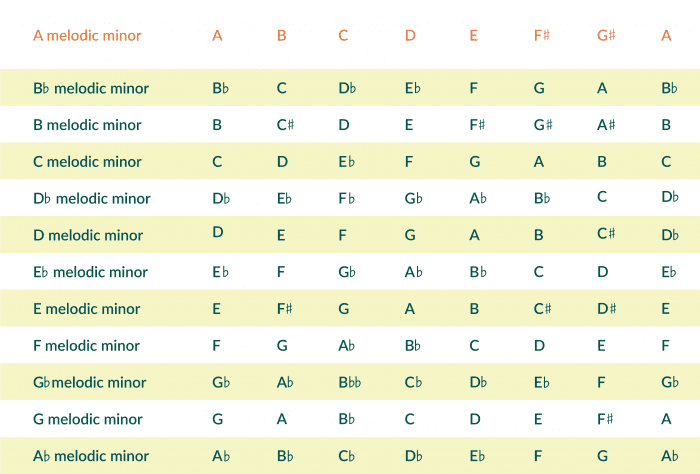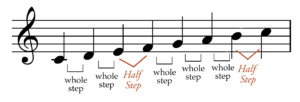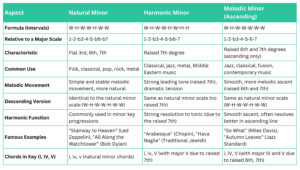What is the melodic minor scale?
The melodic minor scale is a variation on the natural minor piano scale. A natural minor scale is built from the sixth note of the major scale. For example, if we are in the key of C major the relative natural minor scale will be built from A.
C major:

A natural minor:


How to build the melodic minor scale
What is the melodic minor scale? The melodic minor scale is a natural minor scale with raised sixth and seventh scale degrees. As we have seen the notes of the A natural minor scale are:

The sixth and seventh tones of the scale are F and G. If we raise each of them by one half-step, our scale will now consist of A – B – C – D – E – F♯ – G♯ – A. This is an A melodic minor scale.

Try playing them on the piano, noticing the difference in sound.
The melodic minor scale formula
You can also find any minor scale by applying a simple formula to any major scale. In this case flats refer to a scale degrees lowered by a half step. The scale degree formula to create the natural minor scale from major is:
1 – 2 – ♭3 – 4 – 5 – ♭6 – ♭7
The melodic minor formula has raised sixth and seventh scale degrees compared to the natural minor scale, this means that the formula for the melodic minor scale is:
1 – 2 – ♭3 – 4 – 5 – 6 – 7
You can think of melodic minor scales as major scales with a lowered third scale degree. This makes moving between the major and melodic minor scales simple.
The melodic minor chords
Due to the difference in notes melodic minor chords are slightly altered from the standard piano chords in a harmonic or natural minor. The pattern of chord qualities remains the same whatever root you build melodic minor scale chords from.

Take a look at this handy table of all the melodic minor scales if you need any help constructing melodic minors or their chords in any key.
Melodic minor scale intervallic construction
Interval patterns can also be used to memorize scale construction. The interval pattern for the major scale is:
W = (whole step)
H = (half step)
W – W – H – W – W – W – H

Since the melodic minor piano scale is basically a major scale with a flat third scale degree, we will have a nearly identical interval pattern, with a lowered third degree.
The interval pattern for the melodic minor scale is:
W – H – W – W – W – W – H

You can also analyze the intervals from the root of a melodic minor scale in this manner:
A melodic minor | A | B | C | D | E | F# | G# | A |
| Intervals | P1 | M2 | m3 | P4 | P5 | M6 | M7 | P8 |
In this chart, we can visualize the intervals inside the melodic minor scale from the root, A.
- B – a major second away from A (two semitones)
- C – is a minor third away from A (three semitones)
- D – is a perfect fourth away from A (five semitones)
- E – is a perfect fifth away from A (seven semitones)
- F♯ – is a major sixth away from A (nine semitones)
- G♯ -is a major seventh away from A (11 semitones)
Melodic vs natural vs harmonic minor
The harmonic minor is another commonly used variation on the natural minor scale. This minor scale differs from the melodic minor as it only has a raised 7th degree from the natural minor.
Here are the formulas for the harmonic minor scale.
From natural minor: 1 – 2 – 3 – 4 – 5 – 6 – #7
From major: 1 – 2 – ♭3 – 4 – 5 – ♭6 – 7
Here is an example of A harmonic minor:

Let’s compare the differences between the three minor scales we have discussed in this article.

Ascending vs descending melodic minor scale
In some conventions of European classical music the melodic minor is varied depending on whether you are playing it ascending or descending. The ascending melodic minor scale version follows the standard melodic minor pattern.
The descending version follows the pattern of the natural minor scale.
- The ascending version of the A melodic minor scale would be:
A – B – C – D – E – F♯ – G♯ – A - While playing the scale descending it would be:
A – B – C – D – E – F♮ – G♮ – A

Melodic minor scale in classical music and jazz music
However, the melodic minor is not always played as a natural minor when descending. Notably the jazz melodic minor scale keeps its raised 6th and 7th degrees when descending.
See this example in C of a melodic minor scale ascending and descending:

The 7 modes of the melodic minor scale
Just like any other scale in music you can play the melodic minor scale from any degree to achieve different sounds and moods. These modes of the melodic minor scale are a great way to practice hand exercises starting on different melodic minor scale degrees to get the most out of this scale. Let’s take a look at them.
Melodic minor (root position)
As we know the melodic minor in root position sounds like a minor scale with a smoother top end.

Notes: C – D – E♭- F – G – A – B – C
Dorian b2 (2nd mode)
Also known as phrygian #6, this mode sounds dark and interesting due to its lowered second degree. It’s often used in modal jazz and film scores to impart an Eastern or Spanish flavour.

Notes: D – E♭- F – G – A – B – C – D
Lydian augmented (3rd mode)
The lydian augmented scale is similar to the brightness of the standard lydian mode. However the addition of a raised fifth degree gives it a more striking feel. It can often be found being used for dreamy or more cinematic harmony and textures.

Notes: E♭- F – G – A – B – C – D – E♭
Lydian dominant (4th mode)
The lydian dominant, another variation on the lydian scale this time with a flattened 7th degree, gives a bright but bluesy sound.

Notes: F – G – A – B – C – D – E♭- F
Mixolydian b6 (5th mode)
This mode feels very similar to the sound of the standard bluesy mixolydian scale due to the lowered 7th degree. The addition of the lowered 6th degree gives it a bit more bite and is often used over crunchy chords with a dominant function.

Notes: G – A – B – C – D – E♭- F – G
Locrian natural 2 (6th mode)
Locrian natural 2 is smoother than its standard locrian counterpart due to the natural second degree. It can often be found being used over half diminished chords.

Notes: A – B – C – D – E♭- F – G – A
Super locrian (altered scale) (7th mode)
This very tense and spicy mode can also be referred to as an altered scale. The altered scale is a go to scale for many composers and improvisers over an altered dominant chord.

Notes: B – C – D – E♭- F – G – A – B
Songs with melodic minor
Now that we know all about the melodic minor scale it is time to put it into practice with some of Skoove’s amazing lessons. Whether you want to play some classical music like Mozart, a jazz standard such as Autumn Leaves or a pop ballad like Yesterday we have what you’re looking for.
The melodic minor scale is the key to understanding a whole new realm of music theory. This addition to your practice routine will be a great addition to your toolbox. If you ever need any help or guidance Skoove is here to guide you with tips and a wide variety of songs to play. Have fun on your continued musical journey and happy practicing!
Author of this blog post:

Eddie Bond is a multi-instrumentalist performer, composer, and music instructor currently based in Seattle, Washington USA. He has performed extensively in the US, Canada, Argentina, and China, released over 40 albums, and has over a decade experience working with music students of all ages and ability levels.
Published by Lydia Ogn from the Skoove team














